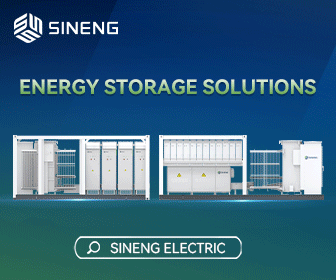Energy Storage Systems - Finding the optimum size

Energy storage systems (ESS) based on high technology Li-ion batteries are fast becoming an essential tool for wind and solar plants. Not only do they help overcome the unpredictability of renewable energy due to changing weather conditions, they also help grid operators combat infrastructure congestion at times of peak supply. The challenge is how to achieve the best match between the size of the ESS and the renewable energy installation?
Ramp rate control and smoothing
The output of solar and wind farms can change suddenly in reaction to changes in wind or cloud coverage - causing a sudden ramp up or down. By controlling the ramp rate, the ESS acts as a buffer and the power injected into the grid is smoothed out. This ensures production remains within the grid operator’s limits, maximizing the amount of power that is accepted onto the grid.
Typically, a battery system for ramp rate control or power smoothing will experience many small charge and discharge cycles as it controls many steps in output. While the average Depth of Discharge (DOD) is around five percent for each step in output, the cumulated “energy throughput” of the battery can represent up to two or three times its total capacity in a 24 hour period.
Power smoothing is similar as it keeps production within a given forecast window, with the ESS compensating for short-term power sags and therefore experiencing many small to medium charge and discharge cycles.
Power shaping
The technique of power shaping uses energy storage to achieve a consistent, predictable flow of energy. The ESS will deliver a daily DOD of 70 percent or higher. It is charged during the peak daylight hours in the middle of the day before discharging in the afternoon, overnight, and in the morning before the sun’s energy is able to achieve the desired output.
Peak shaving
For peak shaving, the ESS will help reduce the load on the grid at periods of peak demand. Equally, wind and solar farms are often limited to supplying power up to a maximum value permitted by the grid operator. So when production is at a peak, the plant operator can store energy, ensuring that they do not experience curtailment and achieve the maximum revenue from the energy they produce.
Frequency regulation
An increasingly important function of energy storage is frequency regulation, for which the ESS absorbs and releases active power onto the grid to keep the grid frequency within its operating limits. Frequency regulation can help the grid accommodate more renewable energy generators. It has traditionally been a service provided by power plants coming online at short notice, but ESSs are now able to perform this role.
While local grid conditions can vary widely, an ESS used for frequency regulation is likely to experience many small charge and discharge operations of three to four percent DOD throughout the day but with energy throughput of up to six times the battery’s energy storage capacity.

Drawing on experience
Practical experience from more than 80MW large-scale Li-ion ESSs deployed worldwide shows that an ESS should be considered as an integral part of the overall scheme, rather than as a standalone installation.
As part of the optimization of an ESS it is vital to consider the Total Cost of Ownership (TCO). This takes account of the initial capital cost, maintenance and operational costs, as well as the cost of curtailments or outages.
Varying the size and specification of a battery changes its cost profile. A smaller ESS will have a lower capital cost but could lead to lower revenues, more penalties, lower compliance with the grid code, or more curtailment losses. It will also alter the system’s calendar life.
To find the optimum ESS an Energy Management Strategy (EMS) must form the basis of a model. It calls for three inputs from the customer. The first of these is knowledge of the legislative environment, including limitations of the electricity grid and local legislation.
Secondly, the operator must survey the actual solar or wind profile from the site. Site-specific measurements take account of local variables and mean that the EMS will be more accurate, improving return on investment.
Lastly, the customer must set its objectives in terms of power output.
The EMS is completed with knowledge of energy storage technology. This includes energy, charge and discharge power capacities, and the effect of aging on the electrochemistry.
Modelling
A set of algorithms can then be used to model the performance of an ESS over its lifetime for any given size of ESS.
By running the model iteratively with different sizes of ESS, the model will identify the sweet spot where the operator will find the best balance between whole life cost and revenue.

Puerto Rico
At a 10MW Puerto Rico PV plant, an ESS has been installed to limit ramp rates and support grid frequency by up to five percent. Modeling identified the optimum size of ESS had a 1.3MWh capacity and 5MW power rating. This balanced the requirements of peak power and the customer’s minimum technical requirements. It also took account of the likely drop in power over the lifetime of the ESS due to aging in order to ensure maximum returns throughout the plant’s lifecycle.
La Réunion
One of the largest Li-ion ESS to date is located at a 9MWp PV plant at Bardzour on La Réunion in the Indian Ocean. Used for power shaping, the ESS ensures power is injected into the grid at a constant 40 percent of the plant’s peak power capacity. It also provides primary reserve for 15 minutes and voltage support.
Modeling identified the optimum size of the ESS as 9MWh energy storage capacity. While a larger system would have had the benefit of higher energy efficiency and a longer lifetime, the capital cost would have been higher. Finding the optimum size for the installation enabled the delivery of the most cost-effective lifetime solution.
Michael Lippert is the marketing and business development manager for energy storage for Saft.
Saft | www.saftbatteries.com
Volume: January/February 2016










